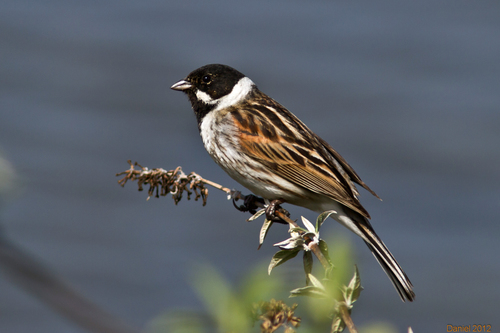
Reed Bunting
The Reed Bunting (Emberiza schoeniclus) is a small passerine bird primarily found in wetlands and reedbeds across Europe and Asia. It plays a crucial role in its ecosystem as both a seed disperser and a food source for larger predators. While not globally threatened, some populations face localized declines due to habitat loss. The male Reed Bunting is easily recognizable during the breeding season by its distinctive black head and white 'moustache'. The species is culturally significant in some regions, often appearing in folklore and literature associated with marshlands.
13.5-15.5 cm
Length
21-26 cm
Wingspan
Least Concern
Conservation Status
Distribution
The Reed Bunting has a wide distribution, breeding across Europe and much of temperate and northern Asia. It extends from the British Isles and Scandinavia in the west to Siberia and Japan in the east. Southern breeding limits reach North Africa, Turkey, and Iran. Northern populations are migratory, wintering in southern Europe, North Africa, and parts of the Middle East and Asia. It shows a broad altitudinal range, from sea level to mountainous regions.
Lifespan
The average lifespan in the wild is around 2-3 years, though some individuals can live longer. Records of banded birds suggest a maximum lifespan of over 10 years is possible.
Reed Bunting's Habitat
Habitat Types
Reedbeds, Marshes, Wet grasslands, Fens, Coastal wetlands
Climate Zones
Temperate, Boreal, Mediterranean
Adaptations
Reed Buntings are well-adapted to wetland environments. Their relatively long legs and strong feet allow them to move easily through dense vegetation. Their bill is adapted for consuming a variety of seeds and invertebrates.
Variations
Numerous subspecies (around 19) of Reed Bunting are recognized, differing in plumage coloration and size. Some island populations, such as those in the British Isles, show distinct characteristics compared to mainland populations.
Appearance
Breeding Plumage
Breeding males have a distinctive black head, white collar, and white 'moustache'. Females and non-breeding males have streaked brown heads and are generally duller in coloration. The underparts are pale with streaking, which is heavier in females.
Seasonal Feather Changes
The male's black head becomes duller and browner in winter, with the white markings becoming less distinct.
Sex Based Plumage Differences
Significant sexual dimorphism is present, particularly during the breeding season. Males are much more strikingly marked than females.
Notable Features
Black head and white 'moustache' (breeding male), Streaked brown plumage (female and non-breeding male), Relatively long tail
Diet and Feeding
Primary Foods
Seeds, Insects, Spiders, Small invertebrates
Foraging Behavior
Reed Buntings forage primarily on the ground or in low vegetation. They often glean seeds from plant heads and search for invertebrates among leaf litter and stems. During the breeding season, they may also take insects from the air.
Specializations
Their bill is adapted for handling a variety of seeds, but it is also capable of capturing small insects.
Seasonal Diet Variations
The diet shifts seasonally. In winter, seeds form the bulk of the diet. During the breeding season, insects and other invertebrates become more important, particularly for feeding young.
Behavior
Social Structure
Reed Buntings are generally solitary or found in pairs during the breeding season. In winter, they often form small flocks, sometimes joining mixed-species flocks with other seed-eating birds.
Communication
A simple, repetitive song (often described as 'chink' or 'cheep'), Contact calls (a soft 'seep'), Alarm calls (a sharp 'zit')
Migration
Northern populations are migratory, undertaking significant journeys to wintering grounds. Southern populations are often resident or only make short-distance movements.
Territorial or Group Behaviors
Males are territorial during the breeding season, defending their nesting area from rivals. Outside the breeding season, they are more gregarious.
Conservation
Threats
Habitat loss (drainage of wetlands), Agricultural intensification, Pesticide use, Climate change (affecting wetland habitats)
Protection Programs
Wetland restoration projects, Agri-environment schemes (promoting wildlife-friendly farming practices), Designation of protected areas (e.g., Ramsar sites)
Local National Laws
Protected under various national and international wildlife legislation, such as the EU Birds Directive.
Population Trend
Decreasing in some regions, particularly in Western Europe, but overall the global population is considered stable.
Population Estimates
The global population is estimated to be in the millions, though precise figures are difficult to obtain.
Interesting Facts
Reed Buntings can sometimes hybridize with other bunting species.
This is relatively rare but has been documented with species like the Little Bunting.
They are known for their ability to cling to vertical reed stems.
This allows them to access food and nesting sites in dense reedbeds.
Their song is often one of the first signs of spring in wetland habitats.
Males start singing early in the year to establish territories.
Faqs about Reed Bunting
What is the difference between a male and female Reed Bunting?
Male Reed Buntings have a black head, white collar, and white 'moustache' during the breeding season, while females have streaked brown heads and are generally duller.
Where do Reed Buntings nest?
They build cup nests low down in dense vegetation, often in reeds or tussocks of grass near water.
What do Reed Buntings eat?
They primarily eat seeds, but also insects, spiders, and other small invertebrates, especially during the breeding season.
Are Reed Buntings endangered?
Reed Buntings are classified as Least Concern by the IUCN, meaning they are not currently considered globally threatened. However, some populations are declining due to habitat loss and other factors.
Copyright @ Nature Style Limited. All Rights Reserved.
 English
English